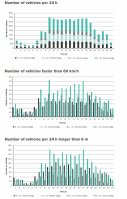As a source of data on traffic intensities, the results of the National Transport Census, which takes place at roughly five-year intervals, are most often used. Within the national traffic census, the number of vehicles passing through a check point per hour is calculated, of which the full-day average is calculated.
Some city road managers annually update car traffic intensities on their road network. When collecting data on traff ic intensities, the manual survey is most often used.
The traff ic intensities are determined using data from automatic traff ic detectors, which, however, mainly due to higher acquisition costs and necessary power infra-structure, are not so numerous due to the total length of roads.
There are, therefore, many sections of the road network where the knowledge of traffic intensities is based on a five-year manual survey conducted by a hired worker. Of
course, in transport, as elsewhere, it is true: Measuring means controlling. The data darkness of the knowledge of the development of traffic density is then negatively
reflected not only in the results of transport models based on the client‘s wishes, but also in complicated decision- making at all levels, i.e. strategic, conceptual, tactical and operative.
Imagine a hired worker who, in any weather, 24 hours a day, seven days a week, hidden (to avoid disturbing the environment) would count cars at a rate of 0,6 Euro / day with an accuracy of more than 97 %... It has to be a robot only. Anyway, today‘s
ICT technology, in conjunction with the Internet of Things, off ers such „robots“ for a marginal price.
CITIQ, a well-known manufacturer of detectors for smart parking systems, produces equally simple detectors for detecting passing vehicles. Autonomous detectors (wireless, self-charging) operate on the principle of detecting change of geomagnetic
fi eld caused by metallic vehicles. Detectors are placed approximately 3-5 cm below the road surface, preferably in the lane axis, but can be installed at the edge of the road no more than 0.5 m from passing vehicles.
Battery life depends on the number / frequency of transmission of traffi c information. For an idea: when transmitting information every ten minutes, the detector battery lifetime is 4 years. When transmitting only 6 times a day, battery life will increase to 7 years.
The installation in the road takes about 20 minutes and immediately after installation, vehicles can travel over the detector. The installation of the detector does not degrade the life of the road and the winter maintenance does not cause any damage to the detector. CITIQ also cares about visual consequences mainly for installations in historic centres, where the surface is made of natural paving stones. CITIQ, in
cooperation with the Transport Research Centre (CDV, v.v.i.) created the so-called smart cube - when the detector is integrated directly into the paving stone and the installation is only a replacement of the existing paving stone by a smart cube. (see photo from the installation in Prague on Dvořák‘s embankment / under the bridge of Štefánik). In the case of two detectors spaced 3 meters apart in the road lane, it is
possible, in addition to intensity, to obtain information on the speed and length of the vehicles.


